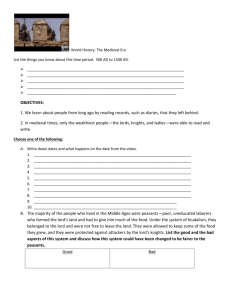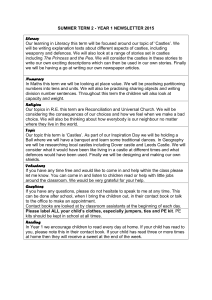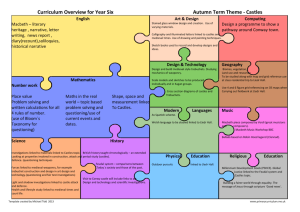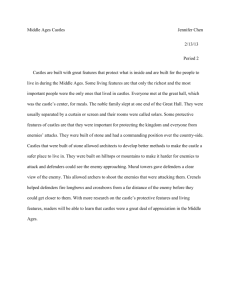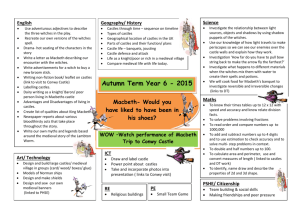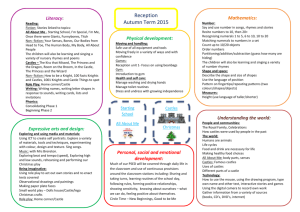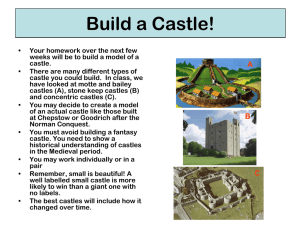Benchmark 2 Review (1) A castle is not the same thing as a palace
advertisement
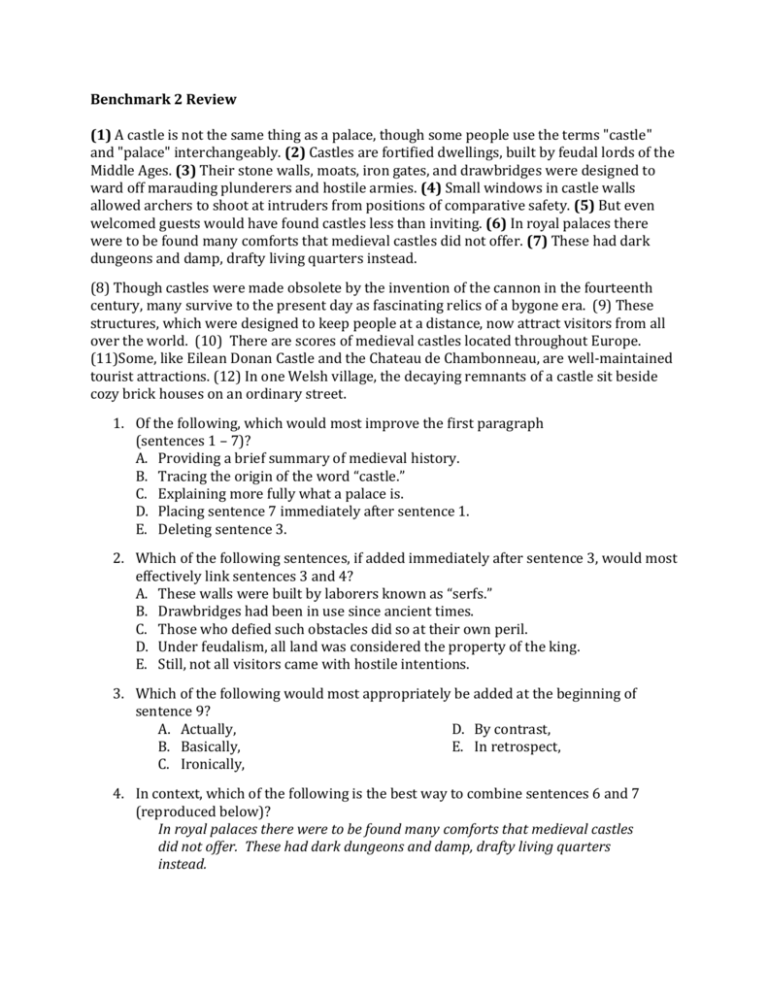
Benchmark 2 Review (1) A castle is not the same thing as a palace, though some people use the terms "castle" and "palace" interchangeably. (2) Castles are fortified dwellings, built by feudal lords of the Middle Ages. (3) Their stone walls, moats, iron gates, and drawbridges were designed to ward off marauding plunderers and hostile armies. (4) Small windows in castle walls allowed archers to shoot at intruders from positions of comparative safety. (5) But even welcomed guests would have found castles less than inviting. (6) In royal palaces there were to be found many comforts that medieval castles did not offer. (7) These had dark dungeons and damp, drafty living quarters instead. (8) Though castles were made obsolete by the invention of the cannon in the fourteenth century, many survive to the present day as fascinating relics of a bygone era. (9) These structures, which were designed to keep people at a distance, now attract visitors from all over the world. (10) There are scores of medieval castles located throughout Europe. (11)Some, like Eilean Donan Castle and the Chateau de Chambonneau, are well-maintained tourist attractions. (12) In one Welsh village, the decaying remnants of a castle sit beside cozy brick houses on an ordinary street. 1. Of the following, which would most improve the first paragraph (sentences 1 – 7)? A. Providing a brief summary of medieval history. B. Tracing the origin of the word “castle.” C. Explaining more fully what a palace is. D. Placing sentence 7 immediately after sentence 1. E. Deleting sentence 3. 2. Which of the following sentences, if added immediately after sentence 3, would most effectively link sentences 3 and 4? A. These walls were built by laborers known as “serfs.” B. Drawbridges had been in use since ancient times. C. Those who defied such obstacles did so at their own peril. D. Under feudalism, all land was considered the property of the king. E. Still, not all visitors came with hostile intentions. 3. Which of the following would most appropriately be added at the beginning of sentence 9? A. Actually, D. By contrast, B. Basically, E. In retrospect, C. Ironically, 4. In context, which of the following is the best way to combine sentences 6 and 7 (reproduced below)? In royal palaces there were to be found many comforts that medieval castles did not offer. These had dark dungeons and damp, drafty living quarters instead. A. Because medieval castles had dark dungeons and damp, drafty living quarters, royal palaces offered many more comforts than could be found there. B. Lacking many comforts compared to royal palaces, medieval castles instead offered dark dungeons and damp drafty living quarters. C. While medieval castles offered only dark dungeons and damp, drafty living quarters, many comforts were to be found in royal palaces. D. Unlike medieval castles, royal palaces offered many comforts not found in dark dungeons and damp, drafty living quarters. E. With their dark dungeons and damp, drafty living quarters, medieval castles offered few of the comforts found in royal palaces. 5. Which of the following sentences would best be added between sentences 11 and 12? A. But not all castles can be considered obsolete. B. Elsewhere, the environment may be a factor. C. However, many travelers prefer to avoid such “tourist traps.” D. Others crumble away in relative obscurity. E. Besides, appearances are often misleading. 6. Which of the following sentences would most effectively be placed after sentence 12? A. In the final analysis, palaces are actually little more than luxurious castles. B. There, medieval austerity stands in bold relief against a background of modern comfort. C. The decline of the castle’s importance as an architectural form coincided with the transformation of medieval society. D. In the United States, imposing structures like Hearst’s Castle are not really castles in the strictest sense of the word. E. Eilean Donan Castle was named for a 7th-century saint who lived as a hermit in the Scottish Highlands. This essay was written in response to an assignment to describe an unusual person or an unusual characteristic in a person. (1) My mother likes to speculate about the infirmities of the great personages of the past. (2) I remember well her analysis of schizophrenia in the Dutch painter, Vincent Van Gogh, and psychological conditions of other famous people. (3)Since I was a young child, I have been fascinated by her theories. (4) She often engages in these musings during sit-down meals with everyone in the family present to offer contrasting views. (5) Mom’s interest in historical aspects of psychology is exciting---more exciting, even, than any of the programs offered by network television. (6) She says that poor programming on the part of the networks is one of the reasons she felt the need to direct our young minds to other, more engaging avenues. (7) Imagine that her speculation is not only an expression of parental concern for child’s welfare but also an outlet for her creative mind. (8)Mom has this unusual interest, it has made me an authority among my peers. (9) Last week, my American Literature teacher launched into a discussion of the writings of Edgar Allen Poe. (10) Before the discussion was over, I was asked to give the class a glimpse of the personal life of Poe. 7. In context, what is the best way to deal with sentence 3? A. Leave it as it is. B. Place it after sentence 7. C. Insert “On the contrary” a the beginning of the last sentence. D. Change “them” to “her theories.” E. Use “and” at the end of sentence 3 to link it with sentence 4. 8. In context, which of the following should be added at the beginning of sentence 7? A. After all, D. I like to B. In fact, E. Then C. You should 9. In context, which of the following is the best way to phrase the underlined portion of sentence 8 (reproduced below)? Mom has this unusual interest, it has made me an authority among my peers. A. (As it is now) B. And so it is my mom’s unusual interest that has made me such C. Because of my mom’s unusual interest, I have become D. As you can see, having my mom’s unusual interest makes me E. Naturally, this unusual interest of my mom’s should have made me 10. In context, which is the best way to deal with sentence 9? A. Add “However,” at the beginning of the sentence. B. Add “For example,” at the beginning of the sentence. C. Add “her name is Ms. Lumberburd” after “teacher.” D. Change “into” to “on.” E. Change “launched” to “launches.” 11. Which of the following sentences would be best to add after sentence 10? A. I confidently related what my mother had taught me about him. B. And in fact, you can bet that really made my day. C. Indeed, my mother had always encouraged me o do my best on such occasions. D. I outlined everything I knew about Poe. E. Famous for his tales of terror, Poe has fascinated readers for 150 years. 12. Where is the most logical place to begin a new paragraph? A. After sentence 3 B. After sentence 5 C. After sentence 6 D. After sentence 7 E. After sentence 10
